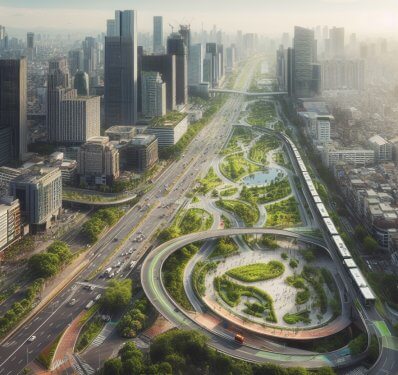Navigating Mobility Madness

[vc_row][vc_column][vc_column_text]City infrastructure, urban development policy, traffic, roads, bridges, flyovers and mass transit; things that we interact with daily. Be it your commute from home to the office, picking up your kids, taking out the family for a ride, or just a casual cruise with your buddies, we all at some point lose ourselves amid mobility madness.
While it is pertinent to note that a proper, sustainable, and a citizen centric approach to infrastructure is vital for change, the subject is far more nuanced than what meets the eye. As discussed in the session, the policy first tends to target the mindset and approach of the people to re-think mobility. It is vital we understand that the subject doesn’t only deal with vehicles and city laws. It deals with the way we function as a society. Climate concerns take centre stage in the primary phase of addressing the issue. Along with that, various other factors come at play that, at prima facie level, appear to be peripheral. Spoiler alert: they are not!
Like all reforms, the drive for sustainable urban development begins with a conscience-stricken public and public administrator realizing the importance and impact of this policy. With public interest surging, it is quickly becoming part of discussions and debate among policy makers. It is heartening to see people, mostly youngsters, exercised about this cause. While it is encouraging that we are slowly waking up to these issues, the work is still quite rudimentary. There will be considerable effort required before we see any change. However, let’s not make the long process make us beholden to hesitation and fear.
Once we set our minds to fix the conundrum, we transition to the next phase: solutions and modalities of mobility. This doesn’t apply to regulating vehicles and mitigating carbon footprints only, but also to re-imagine cities. Re-imagining cities requires us to consider and study sociological, psychological, and cultural aspects of our society. It requires for planners to consider not only environment related problems, but also equitable commuting options, participation in public life, efficient use of city’s resources, and social cohesion. As mentioned above, all these factors seem very loosely linked to the problem of mobility at first. Thorough research and analysis show that these factors act as building blocks for a sustainable urban mobility policy.
The policy recommendations from experts call for a multimodal mobility framework. In layman terms, it is a hybrid model where citizens rely on a half-and-half approach: public and private transport. The Multimodal Mobility concept aims to reduce congestion, mitigate fossil induced pollution, and sharing of city’s resources. This leaves more space for walking tracks, cycling tracks, and most importantly, helps protect the green belts and plantations of the city.
It is simple math really: more people are dependant on private cars, people need roads to drive their cars, city cuts down trees and forests to make way for their cars. Hence, more personal mobility, more concrete, less of the green.
It is imperative that we make the entire framework inclusion; make public transport safer and more accessible for women and children. A paradigm shift is required in policy from being exclusively car-centric to people-centric. Furthermore, tremendous focus should be put on effective data gathering, governance, city designs, and pilot initiatives.
Change is the only constant and being a developing country in an erratic region in an even dynamic world, adapting through effective measures is what can help catapult us at the forefront. If Pakistan wants to lead the fight against climate change and for sustainable development, we require reforms and we require them at the earliest. Re-imagining cities and public spaces shall help us eradicate the “concrete jungles” that our cities have become. Plans of building cycling tracks and introducing electric buses for public transport are encouraging to hear.
Let’s hope that we see a consistent continuation of these measures. A complete over-haul of urban management is required. It is our job to at least ensure that we become less reliant on personal mobility, continue to take part in activism, and put in our effort wherever we can.[/vc_column_text][/vc_column][/vc_row]


